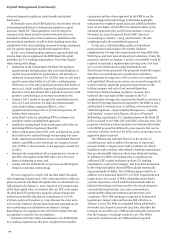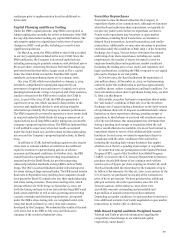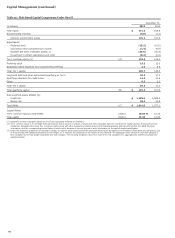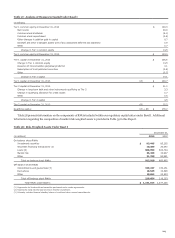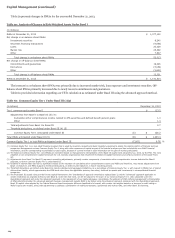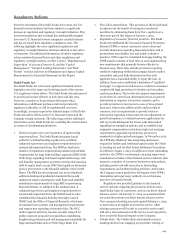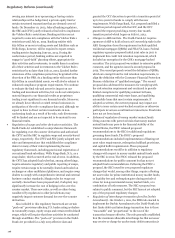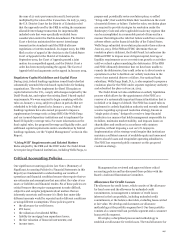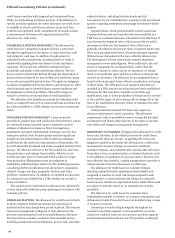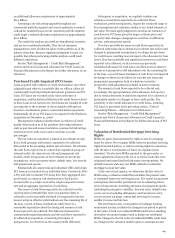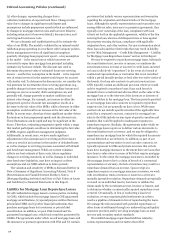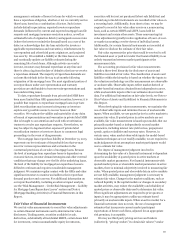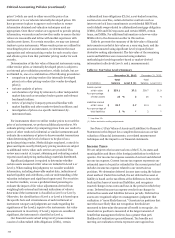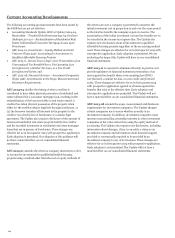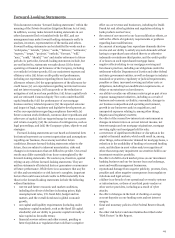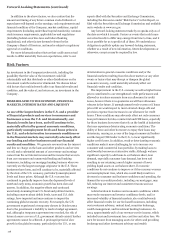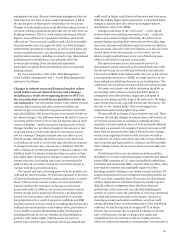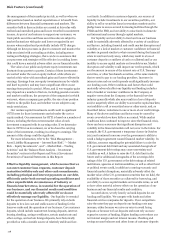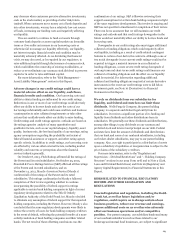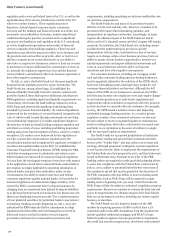Wells Fargo 2013 Annual Report Download - page 112
Download and view the complete annual report
Please find page 112 of the 2013 Wells Fargo annual report below. You can navigate through the pages in the report by either clicking on the pages listed below, or by using the keyword search tool below to find specific information within the annual report.Critical Accounting Policies (continued)
(2) other changes, representing changes due to
collection/realization of expected cash flows. Changes in fair
value due to changes in significant model inputs and
assumptions include prepayment speeds (which are influenced
by changes in mortgage interest rates and borrower behavior,
including estimates for borrower default), discount rates, and
servicing and foreclosure costs.
We use a dynamic and sophisticated model to estimate the
value of our MSRs. The model is validated by an internal model
validation group operating in accordance with Company policies.
Senior management reviews all significant assumptions
quarterly. Mortgage loan prepayment speed – a key assumption
in the model – is the annual rate at which borrowers are
forecasted to repay their mortgage loan principal including
estimates for borrower default. The discount rate used to
determine the present value of estimated future net servicing
income – another key assumption in the model – is the required
rate of return investors in the market would expect for an asset
with similar risk. To determine the discount rate, we consider the
risk premium for uncertainties from servicing operations (e.g.,
possible changes in future servicing costs, ancillary income and
earnings on escrow accounts). Both assumptions can, and
generally will, change quarterly as market conditions and
interest rates change. For example, an increase in either the
prepayment speed or discount rate assumption results in a
decrease in the fair value of the MSRs, while a decrease in either
assumption would result in an increase in the fair value of the
MSRs. In recent years, there have been significant market-driven
fluctuations in loan prepayment speeds and the discount rate.
These fluctuations can be rapid and may be significant in the
future. Therefore, estimating prepayment speeds within a range
that market participants would use in determining the fair value
of MSRs requires significant management judgment.
Additionally, in recent years, we have made significant
adjustments to the assumptions for servicing and foreclosure
costs as a result of an increase in the number of defaulted loans
as well as changes in servicing processes associated with default
and foreclosure management. While our current valuation
reflects our best estimate of these costs, future regulatory
changes in servicing standards, as well as changes in individual
state foreclosure legislation, may have an impact on these
assumptions and our MSR valuation in future periods.
The valuation and sensitivity of MSRs is discussed further in
Note 1 (Summary of Significant Accounting Policies), Note 8
(Securitizations and Variable Interest Entities), Note 9
(Mortgage Banking Activities) and Note 17 (Fair Values of Assets
and Liabilities) to Financial Statements in this Report.
Liability for Mortgage Loan Repurchase Losses
We sell residential mortgage loans to various parties, including
(1) GSEs, which include the mortgage loans in GSE-guaranteed
mortgage securitizations, (2) special purpose entities that issue
private label MBS, and (3) other financial institutions that
purchase mortgage loans for investment or private label
securitization. In addition, we pool FHA-insured and VA-
guaranteed mortgage loans, which back securities guaranteed by
GNMA. The agreements under which we sell mortgage loans and
the insurance or guaranty agreements with FHA and VA contain
provisions that include various representations and warranties
regarding the origination and characteristics of the mortgage
loans. Although the specific representations and warranties vary
among different sales, insurance or guarantee agreements, they
typically cover ownership of the loan, compliance with loan
criteria set forth in the applicable agreement, validity of the lien
securing the loan, absence of delinquent taxes or liens against
the property securing the loan, compliance with applicable
origination laws, and other matters. For more information about
these loan sales and the related risks that may result in liability
see the “Risk Management – Credit Risk Management – Liability
for Mortgage Loan Repurchase Losses” section in this Report.
We may be required to repurchase mortgage loans, indemnify
the securitization trust, investor or insurer, or reimburse the
securitization trust, investor or insurer for credit losses incurred
on loans (collectively “repurchase”) in the event of a breach of
contractual representations or warranties that is not remedied
within a period (usually 90 days or less) after we receive notice of
the breach. Our loan sale contracts to private investors (non-
GSE) typically contain an additional provision where we would
only be required to repurchase loans if any such breach is
deemed to have a material and adverse effect on the value of the
mortgage loan or to the interests of the investors or interests of
security holders in the mortgage loan. The time periods specified
in our mortgage loan sales contracts to respond to repurchase
requests vary, but are generally 90 days or less. While many
contracts do not include specific remedies if the applicable time
period for a response is not met, contracts for mortgage loan
sales to the GSEs include various types of specific remedies and
penalties that could be applied to inadequate responses to
repurchase requests. Similarly, the agreements under which we
sell mortgage loans require us to deliver various documents to
the securitization trust or investor, and we may be obligated to
repurchase any mortgage loan for which the required documents
are not delivered or are defective. In addition, as part of our
representations and warranties in our loan sales contracts, we
typically represent to GSEs and private investors that certain
loans have mortgage insurance to the extent there are loans that
have loan to value ratios in excess of 80% that require mortgage
insurance. To the extent the mortgage insurance is rescinded by
the mortgage insurer due to a claim of breach of a contractual
representation or warranty, the lack of insurance may result in a
repurchase demand from an investor. Upon receipt of a
repurchase request or a mortgage insurance rescission, we work
with securitization trusts, investors or insurers to arrive at a
mutually agreeable resolution. Repurchase demands are typically
reviewed on an individual loan by loan basis to validate the
claims made by the securitization trust, investor or insurer, and
to determine whether a contractually required repurchase event
occurred. Occasionally, in lieu of conducting a loan level
evaluation, we may negotiate global settlements in order to
resolve a pipeline of demands in lieu of repurchasing the loans.
We manage the risk associated with potential repurchases or
other forms of settlement through our underwriting and quality
assurance practices and by servicing mortgage loans to meet
investor and secondary market standards.
We establish mortgage repurchase liabilities related to
various representations and warranties that reflect
110


